| Bydgoszcz | |
|---|---|
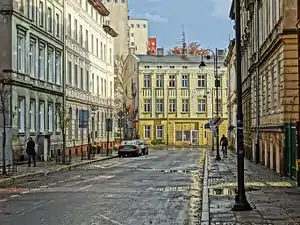 Eastward view of Piotra Skargi street | |
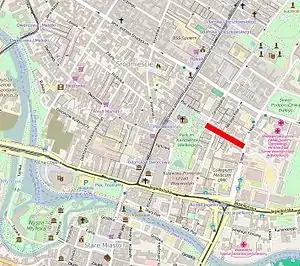 Location of Piotra Skargi street | |
| Native name | Ulica Księdza Piotra Skargi (Polish) |
| Former name(s) | Hoffmann straße |
| Namesake | Piotr Skarga |
| Owner | City of Bydgoszcz |
| Length | 180 m (590 ft) Google maps |
| Area | Downtown district |
| Location | Bydgoszcz, |
| Construction | |
| Construction start | End of the 1860s[1][2] |
| Completion | 1872[1] |
Piotra Skargi street is a historical street of downtown Bydgoszcz.
Location
Piotra Skargi Street is a rather short path, starting at Freedom Square or Plac Wolności, on the west side, and leading eastward to May 3rd street.
History
While the main axis of downtown Bydgoszcz (Polish: Śródmieście), Gdańska Street, grew quickly after 1835, it took more time for side areas to develop as well. The first reference of Piotr Skarga street in city address book of Bromberg dates back to 1872.[1]
First map to mention the street bears the year 1876.[3]
Through history, the street bore the following names:
- 1870s-1920, Hoffmann straße;[1]
- 1920–1940, Piotra Skargi street;[4]
- 1940–1945, Hoffmann straße;[5]
- Since 1945, Piotra Skargi street.
Actual namesake comes from Piotr Skarga (1536–1612), a Polish Jesuit, preacher, hagiographer, polemicist, and leading figure of the Counter-Reformation in the Polish–Lithuanian Commonwealth.
Main edifices
Tenement at 2, in the corner with Casimir the Great Park and Freedom Square
Early 1870s[1]
The house at then Hoffmann straße 13 was initially the villa for the general commanding the 7th Infantry Brigade billeted in Bromberg, today in Pomorska Street.[6] First tenant in 1872 was Ludwig von La Chevallerie.[6] In the 1920s, the tenement was inhabited by displaced Poles that left former eastern territories, or Kresy, as a consequence of the Peace of Riga: Maria Górska and her family.[7] Today, the edifice houses the Regional Inspectorate for the Protection of the Environment (Polish: Wojewódzki Inspektorat Ochrony Środowiska w Bydgoszczy).[8]
The house stands out first by its entry porch adorned with stained glass protect the gate. A frieze with floral motifs runs all around the top. The facade on Piotra Skargi Street shows delicate decoration on the second floor: cartouches displaying human figure, lintels supported by corbels. A terrace stands on the side of the villa giving onto Freedom Square, adorned by pilasters on the ground floor. The building has been extended in the 1970s with a glass extension on park.
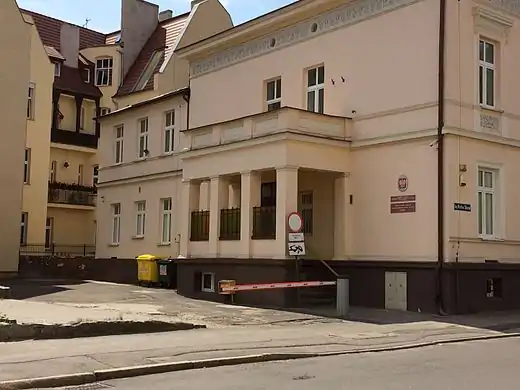 The gate with its loggia
The gate with its loggia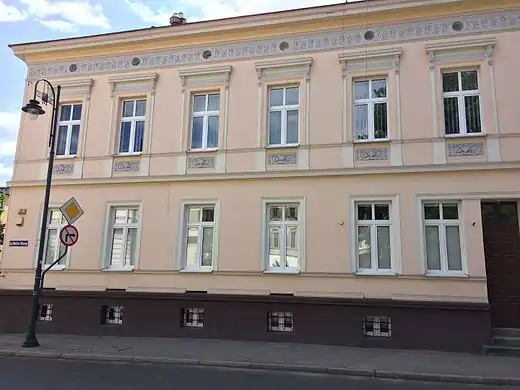 Facade on Piotra Skargi Street
Facade on Piotra Skargi Street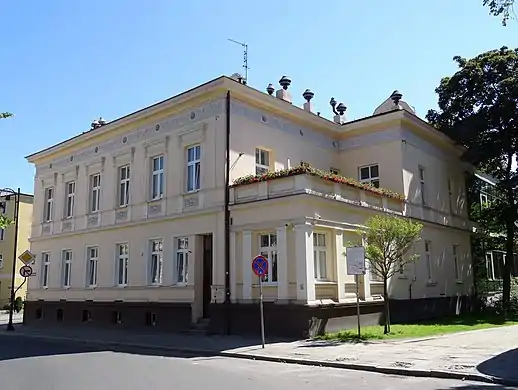 View of the terrace
View of the terrace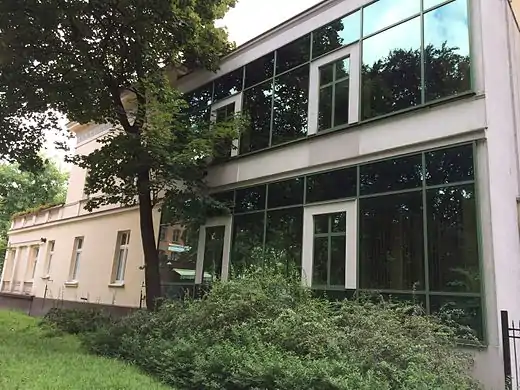 Facade on the park
Facade on the park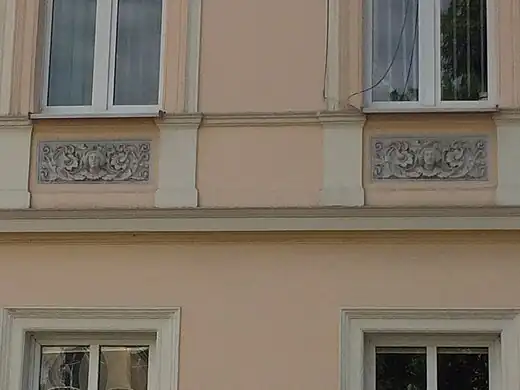 Detail of the cartouches
Detail of the cartouches
Hugo Bille Villa, at 3, corner with Freedom Square
Registered on Kuyavian-Pomeranian Voivodeship heritage list, Reg.A/263/1, May 28, 1991[9]
1886, by Józef Swiecicki and Anton Hoffmann[10]
The villa was designed and built in 1886 for a well-known Bydgoszcz doctor, Hugo Bille.[10] At then Hoffmann straße 1&1a, the ophthalmologist and hospital doctor ran a medical cabinet.[11] Dr. Bille was also a practitioner at the Luisen Stift (in present time Swederowo district) and at the Deaconess hospital (in today's Bielawy district). He was additionally the landlord of a vast tenement at today's 9 Zduny street, at the corner with Warmińskiego street.[12]
In 1910, it was owned by a pensioner Mr Dentler, who had as tenant Julius Von Rogowski, the General Commanding the 4th Artillerie Brigade in Bromberg.[13] After 1920, another physician, Jan Król[14] lived there. He was the owner of the clinic at Gimnazjalna 2a, specialised in nervous diseases. Since 1992, the edifice houses a restaurant, "Villa calvados".[15]
The main elevation of the villa gives onto a small garden, neighbouring Plac Wolności. It has a neoclassical architecture, with a bulky middle avant-corps, highlighted by a semicircle one floor high second avant-corps. the latter is adorned with columns, all the ground floor windows being arched. Larger openings appear on the first floor, with balustrade and pilasters and lintel for chambranle. A small frieze tops the main avant-corps, and a corbel table caps it all. The gate on Piotra Skargi street displays a nice semicircle transom light and delicate carved motifs.
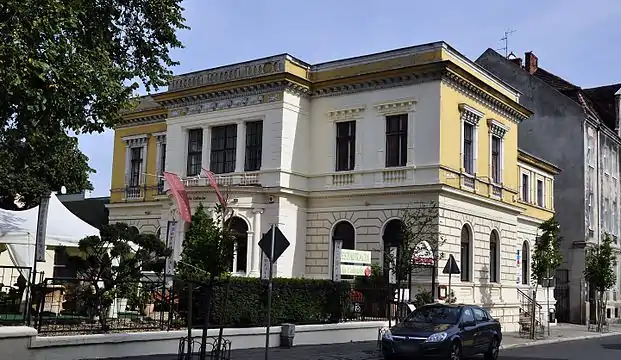 View from Plac Wolności
View from Plac Wolności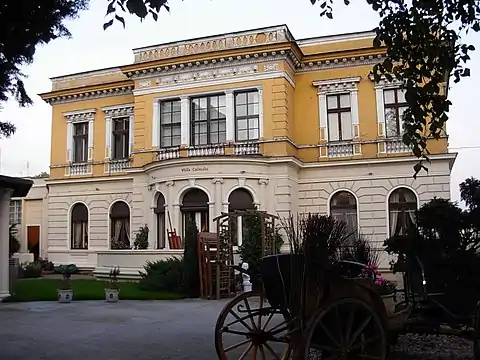 Main elevation
Main elevation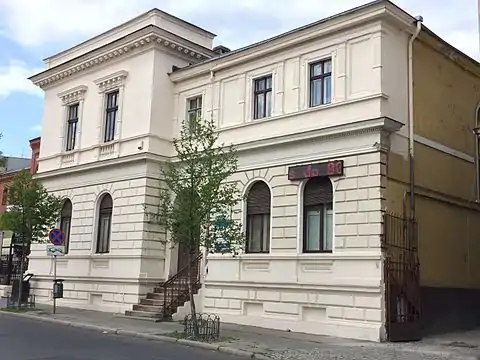 View from the street
View from the street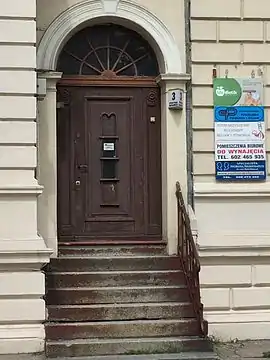 Gate on Piotra Skargi Street
Gate on Piotra Skargi Street
Tenement at 5, corner with corner with Mikołaja Reja Street
1880s[16]
This tenement at then Hoffmann straße 2 was the property of Ms Raaß[17] in 1882, then of Emma Stengert.[16]
None of the original frontage decoration survived. The main elevation is topped by a large triangular pediment. Side facade on Mikołaj Rej street displays a mural painting, "Self-determination" (Polish: Samookreślenie),[18] one of 20 pieces in Bydgoszcz streets.[19]
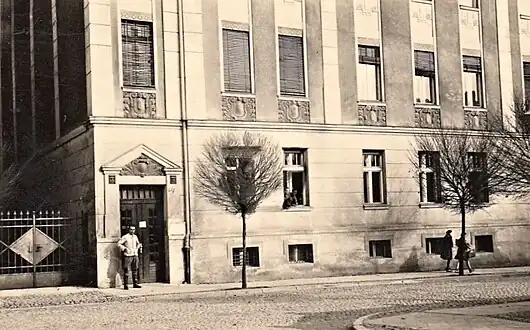 View ca 1945
View ca 1945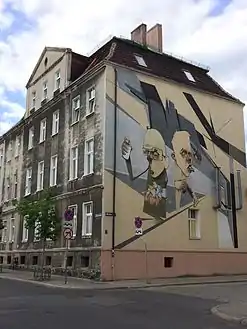 View from the street
View from the street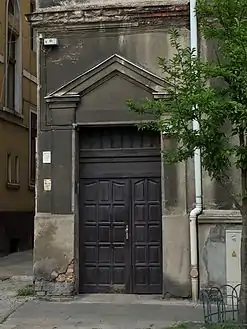 Main gate
Main gate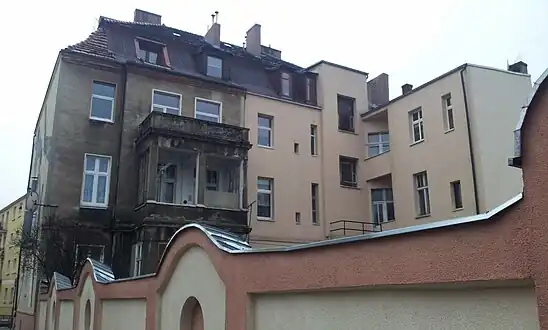 Back view
Back view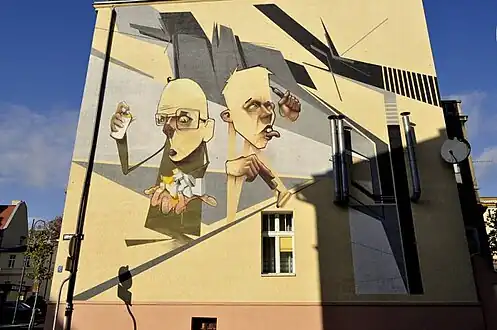 Wall painting at Nr.5
Wall painting at Nr.5
Tenement at 6
1880s[16]
This tenement at then Hoffmann straße 11 has been designed as habitation building for pensioners.
The right-side facade displays a mural painting, Śniadanie Mistrzów (English: Breakfast of Champions) realized by three local artists, Spectrum, Etam and Pain.[20] This work is a part of an ensemble of more than 20 pieces scattered in Bydgoszcz streets.[19]
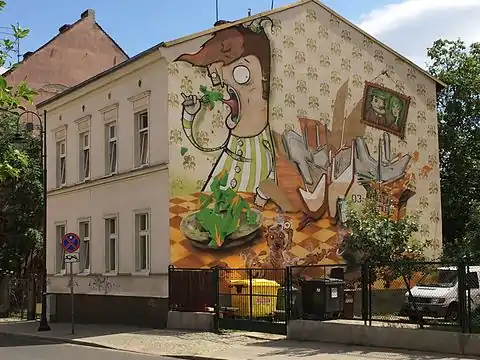 View from the street
View from the street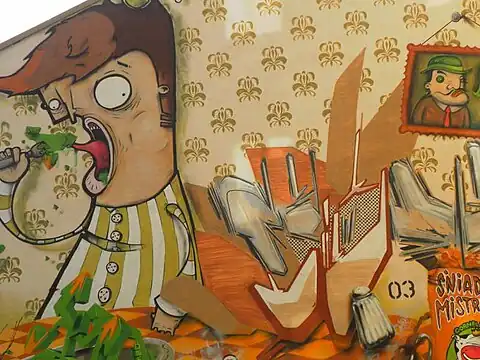 Wall painting at Nr.6
Wall painting at Nr.6
Tenement at 7, corner with Mikołaja Reja Street
Early 1880s[16]
Dr Agnes Schulß, a head teacher, was the first landlord of this tenement at then Hoffmann straße 3.[21] She lived there until the end of World War I.[22] Today, the edifice houses, among others, the "Paderewski Music Society in Bydgoszcz" (Polish: Towarzystwo Muzyczne im. I. J. Paderewskiego w Bydgoszczy), a cultural association engaged in the development of music and musical culture in the city.[23] This association organizes every 3 years the "International Paderewski Piano Competition" in Bydgoszcz: the 10th occurrence will happen from 6 to 20 November 2016.[24]
The facade on Piotra Skargi Street is rather common, except some nice palmette motifs inscribed in cartouches. On the other hand, the elevation on Mikołaj Rej street reveals more decorative features with vegetal ornaments and a stylized festoon topped by an oeil-de-boeuf. This side of the tenement gives access to a garden, overlooked by a balcony.
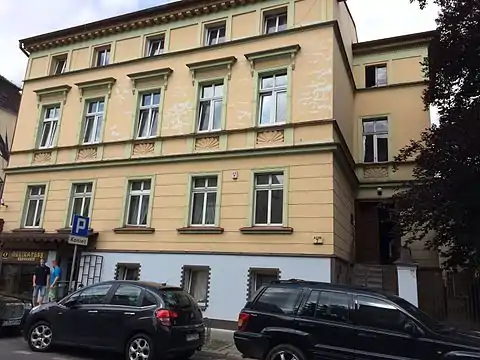 Main elevation from the street
Main elevation from the street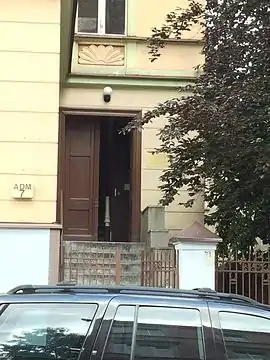 Entry gate
Entry gate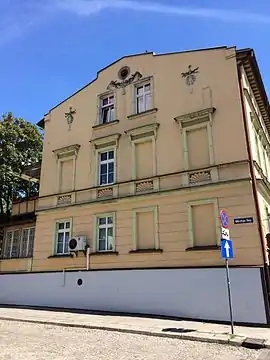 Side facade view
Side facade view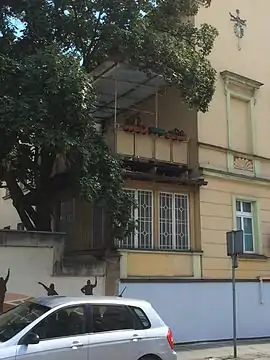 Garden and balcony
Garden and balcony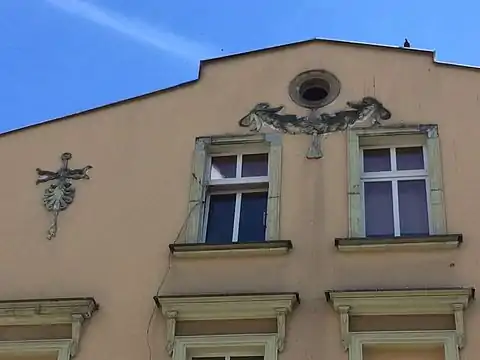 Side facade ornamentation
Side facade ornamentation
Old dairy factory, at 9
1880s[16]
This tenement at then Hoffmann straße 4 was the location of a steam powered dairy factory, in the backyard. Established in the 1880s by Heinrich Engell,[25] then taken over by Michael Diethelm in 1893.[26] The factory which bore his name (Polish: Młeczarnia Diethelm) ran till the outbreak of World War II.[27]
The tenement itself is pretty common. On the left side, in the courtyard, old brick buildings from the dairy factory are still visible, with the main house, the boiler house and the stables.
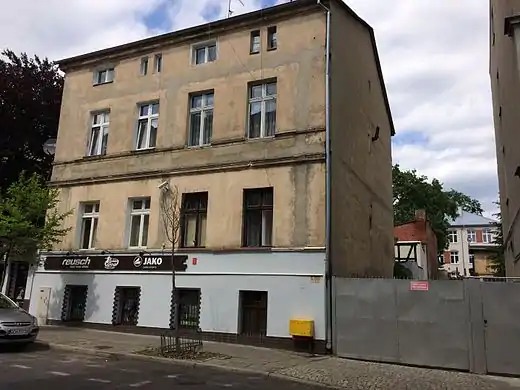 Main elevation
Main elevation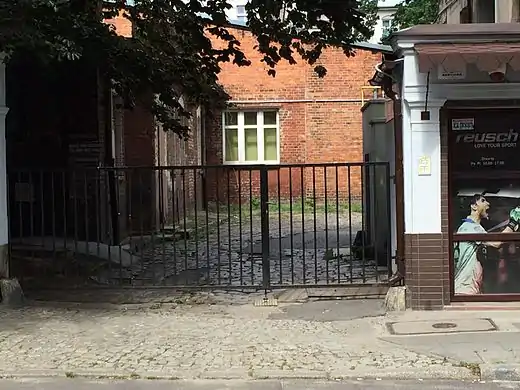 Backyard buildings from the dairy era
Backyard buildings from the dairy era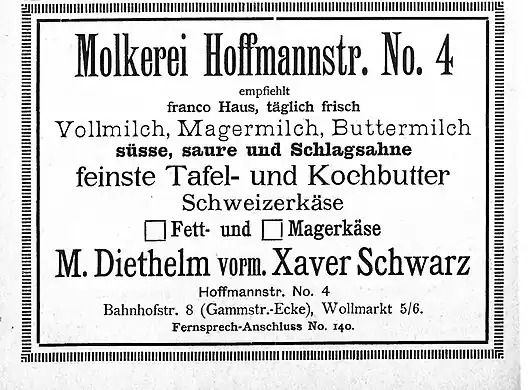 Advertising for Diethelm's dairy factory in 1898
Advertising for Diethelm's dairy factory in 1898
Tenement at 10
1876[16]
This tenement at then Hoffmann straße 9 was first owned by Oswald Wene, a police administrative assistant.[28] It then moved to the hands of pensioners, Mr Sieg and Ms ßommer.[29]
The tenement, with typical eclectic features, was mainly a habitation house. It still retains window pediments on the first floor, festoon motifs at the top of the frontage, as well as an original porch on the side. The edifice has been renovated in 2019.[30]
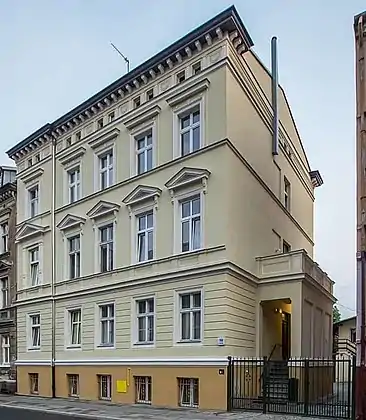 Main elevation after refurbishing
Main elevation after refurbishing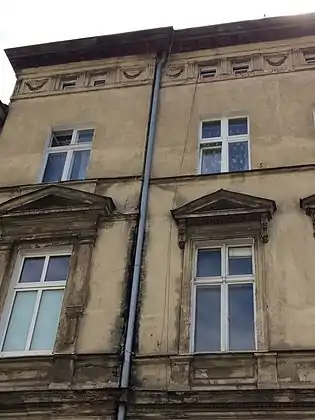 Detail of ornamentation
Detail of ornamentation
Tenement at 12
1877-1878[16]
This tenement at then Hoffmann straße 8 has been designed as a habitation building. In the 1880s, one of the tenants was Ernst Schmid director of the Civic School for Girls (German: Städtische mitlere Töchterschule), in nearby Konarskiego street, now the building of the Bydgoszcz Art School.[31]
The elevation has neoclassical ornamentation: triangular pediments at first floor windows, corbel table at the top, and shed dormer on the gable. The entry still retains its original numbering, "8", painted on the wall.
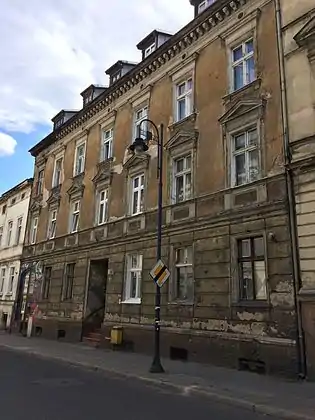 Main facade
Main facade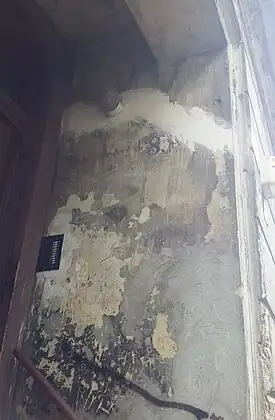 Entry wall with its original number
Entry wall with its original number
Tenement at 13, corner with 3 Maja street
1894-1895[16]
This tenement at then 6 Hoffmann straße has been designed as a habitation building. In the 1890s, one of the tenants were Clara & Hans Joop, photographs, relatives of Theodore Joop, famous photograph of the city: Hans and Clara ran the studio located at Wilhelm straße 15, now Focha Street.[32]
The architecture reflects main features of end of 19th century eclecticism, so present in the streets of Bydgoszcz (e.g. Dworcowa Street, Gdańska Street or Pomorska Street). One can notice arched windows on the ground floor, designed to house shops or restaurant. A small balcony overhangs the corner entry.
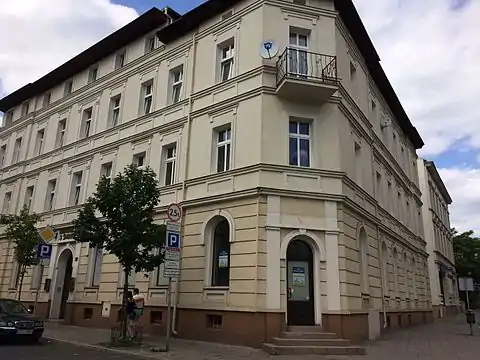 Corner view
Corner view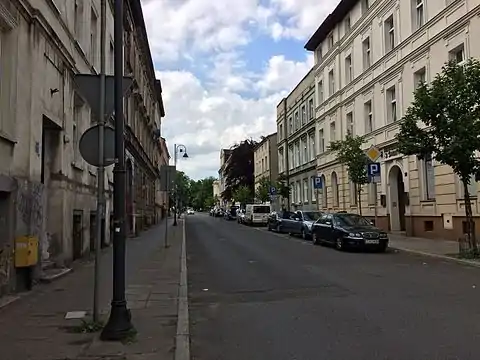 Street view with facade at Nr.13 on the right
Street view with facade at Nr.13 on the right
Tenement at 14, corner with 3 Maja street
1870s[16]
This tenement at then Hoffmann straße 7 has been designed as a renting house by the landlord, Karl Roßoll, living at nearby Hempel straße (now 3 Maja street).[33] From 1927 to 1938,[34] the premises housed the Municipal Institute of Music (Polish: Miejski Instytut Muzyczny), before it moved to 71 Gdańska Street.[35]
The tenement is unfortunately in bad shape.
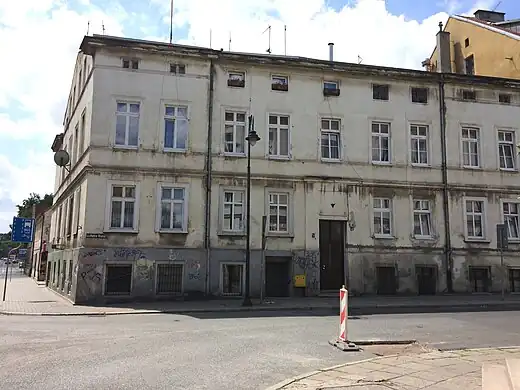 Corner view
Corner view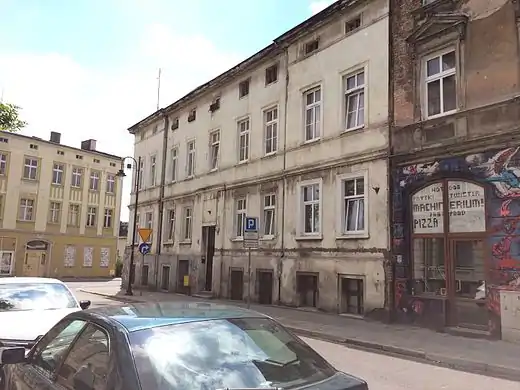 View of the facade on Piotra Skargi street
View of the facade on Piotra Skargi street
See also
References
- 1 2 3 4 5 Adressbuch nebst allgemeinem Geschäfts-Anzeiger von, Bromberg und dessen Vororten auf das Jahr (1872). "Strassen". auf Grund amtlicher und privater Unterlagen. p. XV.
- ↑ 1857 Plan_von_Bromberg_u_Umgegend_B_III_755_mapa_kpbc
- ↑ Plan der Stadt Bromberg 1876, Authogr. Druck u. Verlag v. Paul Berthold Jaekel, Bromberg
- ↑ Plan Miasta Bydgoszczy, 1933
- ↑ Stadt Bauamt, Bromberg, 10 VII 1941
- 1 2 Wegner, Günter (1990). Stellenbesetzung der Deutschen Heere 1815 - 1939. Osnabrück: Biblio. ISBN 3-7648-1780-1.
- ↑ CHMIELEWSKA, GIZELA (16 September 2012). "Adres bydgoski: ulica Piotra Skargi 2". pomorska.pl. Gazeta Pomorska. Retrieved 16 June 2016.
- ↑ "BIULETYN INFORMACJI PUBLICZNEJ WIOŚ W BYDGOSZCZY". bip.wios.bydgoszcz.pl. WIOŚ w Bydgoszczy. 2016. Retrieved 16 June 2016.
- ↑ zabytek|kujawsko-pomorskie|issued=1.03.2014
- 1 2 Derkowska-Kostkowska, Bogna (2001). Józef Swiecicki – szkic biografii bydgoskiego budowniczego. Bydgoszcz: Materialy do Dziejów Kultury i Sztuki Bydgoszczy i Regionu, zeszyt 6. p. 32.
- ↑ Adressbuch nebst allgemeinem Geschäfts-Anzeiger von Bromberg und dessen Vororten auf das Jahr 1896. Bromberg: Dittmann. 1896. p. 15.
- ↑ Adressbuch nebst allgemeinem Geschäfts-Anzeiger von Bromberg mit Vorvorten für 1893. Bromberg: Gardiewski. 1893. pp. 6, 17, 30.
- ↑ Adressbuch nebst allgemeinem Geschäfts-Anzeiger von Bromberg und dessen Vororten auf das Jahr 1910. Bromberg: Dittmann. 1910. p. 115.
- ↑ Książka Adresowa Miasta Bydgoszczy : wydana w roku 1926. Bydgoszcz: Zakłade Grficzne "Bibljoteka Polska" w Bydgoszczy. 1926. p. 126.
- ↑ "Restauracja Villa Calvados". villacalvados.pl. villacalvados. 2015. Retrieved 18 June 2016.
- 1 2 3 4 5 6 7 8 9 Jasiakiewicz, Roman (24 April 2013). Uchwala NR XLI/875/13. Bydgoszcz: Miasta Bydgoszczy. p. 123.
- ↑ Adressbuch nebst allgemeinem Geschäfts-Anzeiger von Bromberg und dessen Vororten auf das Jahr 1883. Bromberg: Dittmann. 1883. p. 90.
- ↑ "Mural "Samookreślenie"". visitbydgoszcz.pl. visitbydgoszcz. 2016. Retrieved 18 June 2016.
- 1 2 "Murale". visitbydgoszcz.pl. visitbydgoszcz. 2016. Retrieved 18 June 2016.
- ↑ "Mural "Śniadanie Mistrzów"". visitbydgoszcz.pl. visitbydgoszcz. 2016. Retrieved 5 January 2022.
- ↑ Adressbuch nebst allgemeinem Geschäfts-Anzeiger von Bromberg und dessen Vororten auf das Jahr 1884. Bromberg: Dittmann. 1884. p. XXIV.
- ↑ Adressbuch nebst allgemeinem Geschäfts-Anzeiger von Bromberg und dessen Vororten auf das Jahr 1917. Bromberg: Dittmann. 1917.
- ↑ "Towarzystwo Muzyczne im. Ignacego Jana Paderewskiego". bazy.ngo.pl. ngo pl. 2016. Retrieved 19 June 2016.
- ↑ "International Paderewski Piano Competition". konkurspaderewskiego.pl. The Paderewski Music Association. 2016. Retrieved 19 June 2016.
- ↑ Adressbuch nebst allgemeinem Geschäfts-Anzeiger von Bromberg und dessen Vororten auf das Jahr 1886. Bromberg: Dittmann. 1886. p. XXII.
- ↑ Adressbuch nebst allgemeinem Geschäfts-Anzeiger von Bromberg und dessen Vororten auf das Jahr 1893. Bromberg: Dittmann. 1893. p. 33.
- ↑ Phone book. Bydgoszcz. 1939. p. 25.
{{cite book}}: CS1 maint: location missing publisher (link) - ↑ Adressbuch nebst allgemeinem Geschäfts-Anzeiger von Bromberg und dessen Vororten auf das Jahr 1878. Bromberg: Dittmann. 1878. p. 126.
- ↑ Adressbuch nebst allgemeinem Geschäfts-Anzeiger von Bromberg und dessen Vororten auf das Jahr 1890 und 1900. Bromberg: Dittmann. p. XIX.
- ↑ "[REMONTY KAMIENIC] SIERPIEŃ 2019 CZ. 2". bydgoszczwbudowie.pl. Bydgoszcz w Budowie. 2019. Retrieved 3 August 2022.
- ↑ Adressbuch nebst allgemeinem Geschäfts-Anzeiger von Bromberg und dessen Vororten auf das Jahr 1880. Bromberg: Dittmann. 1880. p. XXII.
- ↑ Adressbuch nebst allgemeinem Geschäfts-Anzeiger von Bromberg und dessen Vororten auf das Jahr 1896. Bromberg: Dittmann. 1896. p. 76.
- ↑ Adressbuch nebst allgemeinem Geschäfts-Anzeiger von Bromberg und dessen Vororten auf das Jahr 1896. Bromberg: Dittmann. 1869. p. 76.
- ↑ ANISZEWSKA-MINCER, BARBARA (1983). Od szkólki parafialnej do Akadenrli Muzycznej. Bydgoszcz: Kalendarz Bydgoski. p. 101.
- ↑ Kotowicz, Filip (2010). "Historia Szkoły". szkolamuzyczna.bydgoszcz.pl. szkolamuzyczna.bydgoszcz. Retrieved 19 June 2016.
External links
Bibliography
- (in Polish) Umiński, Janusz (1996). Bydgoszcz, Przewodnik. Bydgoszcz: Regionalny Oddział PTTK "Szlak Brdy".
- (in Polish) Denisuk, Andrzej (1990). Z działalności Towarzystwa Muzycznego w Bydgoszczy. Kronika Bydgoska X. Bydgoszcz: Towarzystwo Miłosnikow Miasta Bydgoszczy - Bydgoskie Towarzystwo Naukowe. pp. 205–212.
- (in Polish) Pruss Zdzisław, Weber Alicja, Kuczma Rajmund (2004). Bydgoski leksykon muzyczny. Bydgoszcz: Kujawsko-Pomorskie Towarzystwo Kulturalne.
- (in Polish) Przecherko, Tadeusz (2003). Osiemdziesiąt lat minęło... Kalendarz Bydgoski. Bydgoszcz: Towarzystwo Miłośników Miasta Bydgoszczy.
